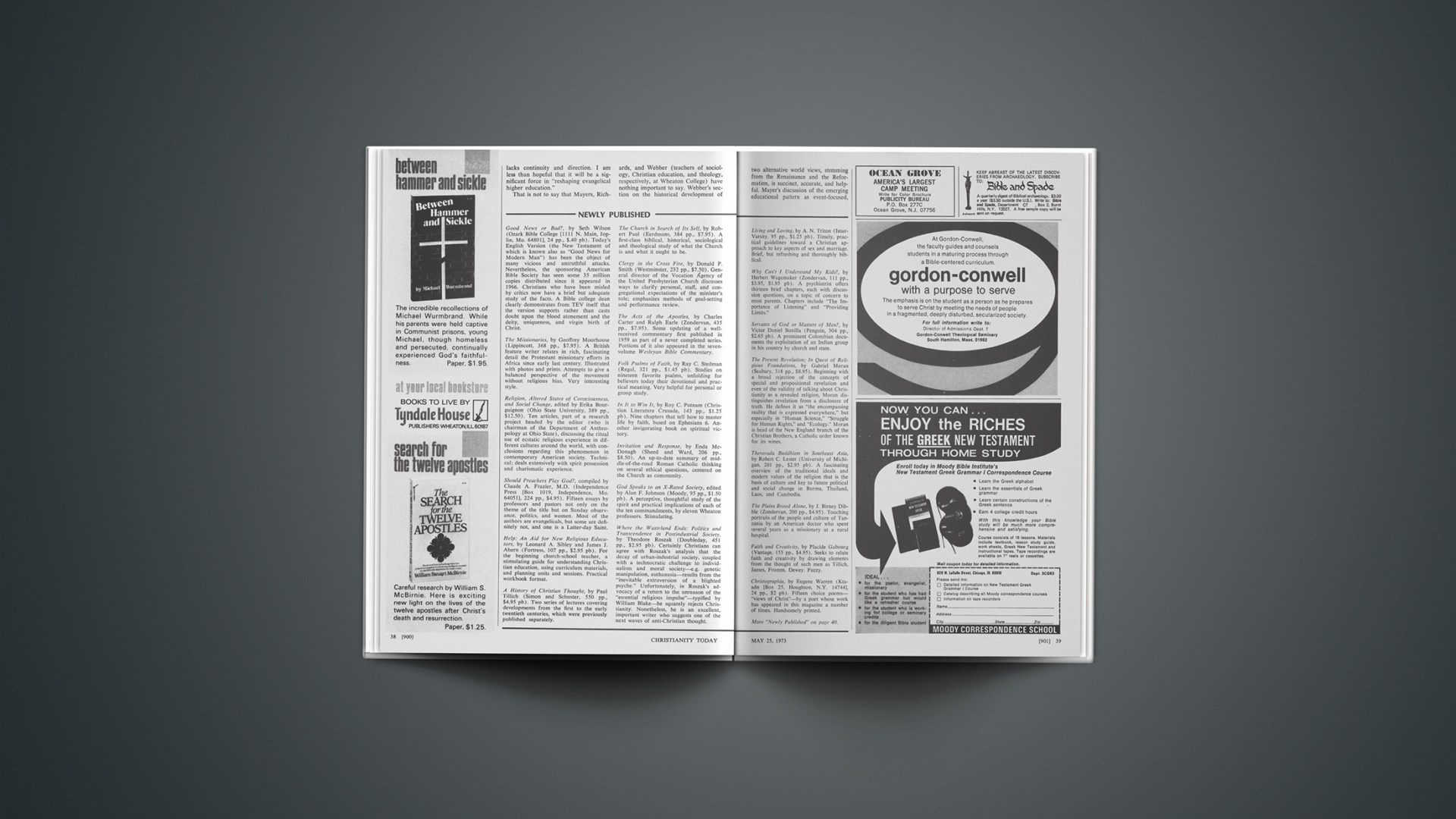Jesus the Messiah: An Illustrated Life of Christ, by Donald Guthrie (Zondervan, 1972, 386 pp., $6.95), A Shorter Life of Christ, by Donald Guthrie (Zondervan, 1970, 186 pp., $2.45 pb), and The Gospels in Current Study, by Simon Kistemaker (Baker, 1972, 171 pp., $2.95 pb), are reviewed by Donald Hagner, assistant professor of Bible, Wheaton College, Wheaton, Illinois.
It is a treat to have two books on the life of Christ from the veteran British New Testament scholar Donald Guthrie, perhaps best known to American readers for his excellent New Testament introduction. The Shorter Life presents the substance of Guthrie’s article in the forthcoming Zondervan Pictorial Encyclopedia of the Bible. It includes not only background material and a sketch of the life of Jesus but also a discussion of critical questions associated with the subject, as well as special treatment of the teaching and miracles of Jesus and of the Christology of the early Church. Guthrie shows himself thoroughly familiar with modern criticism of the Gospels from redaction criticism to New Quest. Although he is willing to learn what he can from the modern debate, he fair-mindedly and honestly holds to a solidly evangelical perspective. Against much scholarly opinion, Guthrie adamantly refuses to allow a wedge to be driven between the Jesus of history and the Christ of faith. The recognition of the gospel writers as theologians writing from the standpoint of post-resurrection faith, Guthrie rightly insists, does not mean they cannot also have been careful historians.
In Jesus the Messiah Guthrie writes at the popular level, giving no space to discussion of background or critical questions; he limits himself to a full description of the life of Christ from the annunciation to the resurrection. The book virtually amounts to a concise commentary on a harmony of the four Gospels, proceeding passage by passage chronologically; its arrangement would enable it to lend itself well to six months of daily Bible study. An added attraction are photographs of the Holy Land, related to the text. Although this is easy, non-technical reading, the perceptive reader will quickly sense the author’s theological depth and learning. The book serves as a fine example of biblical scholarship in the service of the average layman.
Unfortunately, Guthrie’s two volumes are only somewhat complementary, since about a third of the Shorter Life is given over to a sketch of the life and ministry of Jesus and thereby overlaps the content of the larger volume. I would have preferred a volume entirely devoted to critical questions.
Guthrie’s handling of the life of Christ in both volumes is an excellent illustration of what a judicious stance on matters of criticism can produce. When confronted with chronological difficulties in the Gospels, Guthrie will on occasion harmonize (tentatively), but will also give full weight to the authors’ right to order the materials in keeping with their distinctive purposes. The outcome, however, is not historical skepticism but a confidence in the broad chronological framework and the historicity of the narrative. Thus, for example, Guthrie says that the difficulty in reconciling the accounts of the resurrection appearances, rather than detracting from the historical reliability of the events, enhances it by ruling out collusion between the writers or the use of a common source. Also notable in Guthrie’s work are the excellent material on the purpose and interpretation of the parables, the fairness with which he discusses Pharisaism, and the consistent defense of the reality of the supernatural in the Gospels.
Guthrie knows the problems and faces them squarely, seldom contenting himself with a facile explanation. His work in the sensitive area of the Gospels shows that evangelical convictions and a moderate use of criticism are not inimical. But the best thing about these books is Guthrie’s ability to capture the essence of matters so beautifully, often shedding considerable light in a single sentence.
The person looking for a popular yet more detailed treatment of certain modern critical questions associated with the study of the Gospels would do well to turn to Simon Kistemaker’s volume. Kistemaker, a professor at Reformed Theological Seminary in Jackson, Mississippi, covers topics ranging from the textual to the theological, including more unusual subjects such as the Gospel of Thomas and audience criticism. The various essays are self-contained units.
Kistemaker has produced an excellent account of modern critical study seen from an evangelical perspective. Like Guthrie, he shows admirable honesty in his approach. He rightly argues that the serious evangelical interpreter cannot simply ignore the methodologies of radical criticism. The theological purpose of a gospel writer may take precedence over chronological sequence, he maintains, but the theological interest itself does not rule out concern for the historical.
Kistemaker’s answers to the claims of radical criticism are usually quite brief, but often incisive. (Unfortunately, the section of the Dead Sea Scrolls could not have anticipated O’Callaghan’s alleged fragments of Mark from Cave 7 at Qumran.) This volume provides a handy and excellent overview of questions in gospel criticism that by their nature and difficulty often repel evangelicals but for the same reasons are of great importance to an informed and effective evangelical voice in our day.










